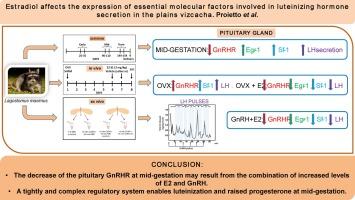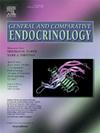雌二醇会影响平原麝黄体生成素分泌过程中重要分子因子的表达。
IF 1.7
3区 医学
Q3 ENDOCRINOLOGY & METABOLISM
引用次数: 0
摘要
平原鼢鼠在妊娠中期表现出下丘脑-垂体-卵巢(HPO)轴活动的重新激活。下丘脑促性腺激素释放激素(GnRH)在妊娠中期分泌,随后卵泡刺激素(FSH)和黄体生成素(LH)分泌,使这一过程得以实现。然而,垂体促肾上腺皮质激素受体(GnRHR)的表达也随之减少。此外,还发现垂体雌激素受体α(ERα)的表达增加。这项工作旨在研究雌二醇(E2)对GnRHR表达、转录因子早期生长应答蛋白-1(Egr-1)和类固醇生成因子-1(Sf-1)以及LH分泌的影响。研究人员采用了三种实验方法:一种是利用怀孕的平原雌鼠进行生理学实验,一种是利用卵巢切除(OVX)动物并用 E2(OVX + E2)进行体内实验,还有一种是利用垂体腺体暴露于 GnRH 和 E2 的组合进行体外实验。在妊娠中期,Sf-1和Egr-1的垂体表达明显增加。卵巢切除术明显增加了腺垂体GnRHR、Egr-1和Sf-1的表达水平以及LH的分泌。然后,卵巢切除+E2显示出与SHAM相似的水平。暴露于GnRH的腺垂体显示出诱导的GnRHR、Egr-1和Sf-1表达以及LH分泌,而GnRH + E2则恢复了这些变化。妊娠中期垂体 GnRHR 的减少可能是 E2 和 GnRH 分泌增加共同作用的结果。然而,妊娠中期 Egr-1 和 Sf-1 表达的增加,以及 LH 的释放,表明妊娠中期发生了紧密而复杂的调节系统,使新的孕酮激增,成功地将妊娠进行到足月 新发现:研究发现,妊娠中期平原膀胱垂体中的 Sf-1 和 Egr-1 显著增加。此外,E2还能逆转卵巢切除的雌鼠垂体和暴露于GnRH的体外垂体中GnRHR、Egr-1、Sf-1和LH的增加。妊娠中期垂体 GnRHR 的下降可能是 E2 和 GnRH 水平升高的结果。妊娠中期可能会出现一个紧密而复杂的调节系统,使孕酮的新一轮激增能够将妊娠进行到足月。本文章由计算机程序翻译,如有差异,请以英文原文为准。

Estradiol affects the expression of essential molecular factors involved in luteinizing hormone secretion in the plains vizcacha
The plains vizcacha is a rodent that shows reactivation of the hypothalamic–pituitary–ovary (HPO) axis activity at mid-gestation. This process is enabled by the secretion of hypothalamic gonadotropin-releasing hormone (GnRH) at mid-gestation, followed by follicle-stimulating hormone (FSH) and luteinizing hormone (LH) secretion. However, a decrease in the pituitary GnRH receptor (GnRHR) expression is concomitantly determined. Moreover, an increment in the pituitary expression of estrogen receptor alpha (ERα) has been determined. This work aimed to study the impact of estradiol (E2) on GnRHR expression, the transcription factors early growth response protein-1 (Egr-1) and steroidogenic factor-1 (Sf-1), as well as on LH secretion. Three experimental approaches were performed: a physiological one with pregnant plains vizcachas, an in vivo approach with ovariectomized (OVX) animals treated with E2 (OVX + E2), and an ex vivo approach using pituitary glands exposed to a combination of GnRH and E2. Significant increased pituitary expression of Sf-1 and Egr-1 was determined at mid-gestation. Ovariectomy significantly increased adenohypophyseal expression levels of GnRHR, Egr-1, and Sf-1, as well as LH secretion. Then, OVX + E2 showed similar levels to SHAM. Adenohypophyses exposed to GnRH showed induced GnRHR, Egr-1, and Sf-1 expression, and LH secretion, while GnRH + E2 reverted these changes. The mid-gestation pituitary GnRHR decrease may result from the combination of increased E2 and GnRH secretion. Nevertheless, the increased expression of Egr-1 and Sf-1 at mid-gestation, together with LH release, suggests the tightly and complex regulatory system that takes place at mid-gestation, enabling a new progesterone surge that successfully carries the pregnancy to term.
New & Noteworthy
A significant increment of Sf-1 and Egr-1 at the pituitary of mid-gestating plains vizcachas was determined. Moreover, E2 reverted GnRHR, Egr-1, Sf-1, and LH increase in ovariectomized vizcachas’ pituitaries and ex vivo pituitaries exposed to GnRH. The decrease of the pituitary GnRHR at mid-gestation may result from the increased E2 and GnRH levels. A tightly and complex regulatory system may take place at mid-gestation enabling a new surge of progesterone that carries pregnancy to term.
求助全文
通过发布文献求助,成功后即可免费获取论文全文。
去求助
来源期刊

General and comparative endocrinology
医学-内分泌学与代谢
CiteScore
5.60
自引率
7.40%
发文量
120
审稿时长
2 months
期刊介绍:
General and Comparative Endocrinology publishes articles concerned with the many complexities of vertebrate and invertebrate endocrine systems at the sub-molecular, molecular, cellular and organismal levels of analysis.
 求助内容:
求助内容: 应助结果提醒方式:
应助结果提醒方式:


